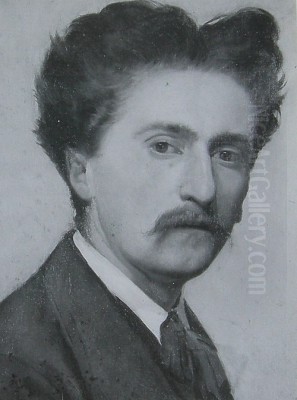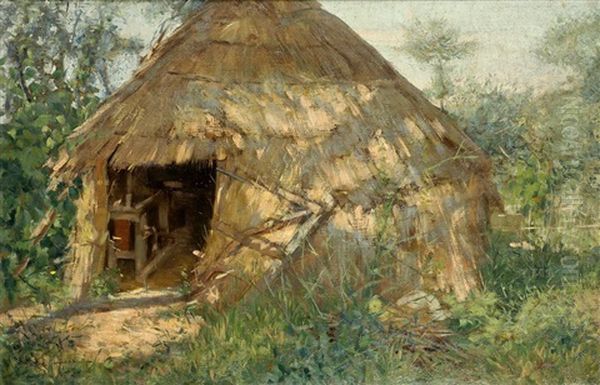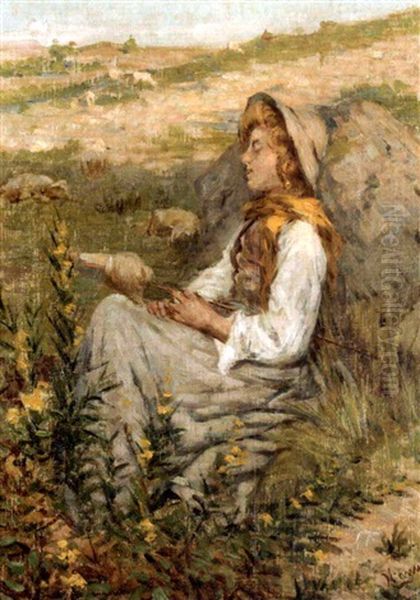
Niccolò Cannicci (1846–1906) stands as a significant figure in late 19th-century Italian art, a painter whose canvases captured the serene beauty of the Tuscan countryside and the quiet dignity of its inhabitants. Born and artistically nurtured in Florence, Cannicci's work evolved from the traditions of the Macchiaioli to embrace a more personal, lyrical interpretation of landscape and genre scenes, often imbued with a subtle, impressionistic sensibility. His legacy is one of dedication to the nuances of light, a profound connection to his native land, and an ability to convey deep emotion through his depictions of everyday rural life.
Early Life and Artistic Formation in Florence
Niccolò Cannicci was born in Florence on October 29, 1846. His artistic inclinations were perhaps inherited, as his father, Gaetano Cannicci, was himself a skilled painter. This familial environment likely provided early exposure to the world of art. His formal training began at the prestigious Accademia di Belle Arti di Firenze (Florence Academy of Fine Arts), a crucible of artistic talent in Tuscany.
At the Accademia, Cannicci studied under notable masters who shaped his foundational skills. Among his instructors were Enrico Pollastrini, known for his historical paintings and academic rigor, and Antonio Cioni. He also reportedly studied with Marino Marini (though this might refer to a different Marino Marini, or perhaps a less documented aspect of his early training, as the famous sculptor Marino Marini was born later; the provided text mentions "Marino Marini" and "Enrico Pollastri" as teachers at the Accademia, and later "Antonio Cioni's school"). Giuseppe Mancinelli was another figure who contributed to his artistic education during his Florentine years. Cannicci also participated in the activities of the "scuola libera del nudo" (free school of the nude), which emphasized direct observation and anatomical understanding.
This academic grounding provided him with technical proficiency, but like many artists of his generation, Cannicci would soon look beyond the strictures of academic art to find his own voice, particularly drawn to the revolutionary approaches to light and landscape emerging at the time.
The Macchiaioli Influence and the Embrace of Impressionism

Cannicci is often associated with the second generation of the Macchiaioli, a group of Italian painters active primarily in Tuscany from the 1850s. The Macchiaioli, including seminal figures like Giovanni Fattori, Telemaco Signorini, and Silvestro Lega, rebelled against the prevailing academic conventions. They advocated for painting en plein air (outdoors) to capture the immediate effects of light and shadow, using macchie (patches or spots of color) to define form and create a sense of realism and immediacy.
While Cannicci inherited aspects of the Macchiaioli tradition, particularly their commitment to outdoor painting and their focus on Tuscan landscapes and rural life, his artistic journey led him towards a more nuanced and personal interpretation. A pivotal moment in his development occurred in the spring of 1875. He embarked on a journey with fellow artist friends, including Francesco Gioli, the established Macchiaiolo Giovanni Fattori, and Egisto Ferroni (sometimes referred to as Eugenio Ferreri in sources). This experience, and his exposure to broader European artistic currents, profoundly impacted his style.
Following this period, Cannicci began to employ a more vibrant palette and a freer, more spontaneous brushstroke, characteristics aligned with Impressionism. While he never fully adopted the broken color techniques of French Impressionists like Claude Monet or Camille Pissarro, the influence is undeniable in the atmospheric quality and luminous effects of his later works. He sought to capture the fleeting moments of light and the poetic essence of nature, moving beyond the more structured compositions of the earlier Macchiaioli.
Artistic Style and Thematic Concerns
Niccolò Cannicci's artistic output is predominantly characterized by landscapes, particularly scenes of the Tuscan countryside, and genre paintings depicting rural life. His work is marked by a deep sensitivity to the natural world and an empathetic portrayal of peasant figures. He was a master of capturing the changing light of the Tuscan hills, the textures of the earth, and the quiet rhythms of agricultural life.
His style can be described as a blend of naturalism and a lyrical Impressionism. He meticulously observed nature, yet his paintings were not mere topographical records. Instead, they were imbued with a poetic and often melancholic atmosphere. He favored scenes of fields, harvests, country paths, and simple dwellings, often populated by solitary figures or small groups engaged in daily tasks. These figures are rendered with dignity, becoming integral parts of the landscape rather than mere accessories.

Cannicci's palette, especially in his mature period, became brighter and more varied, reflecting the Impressionist concern with capturing the optical effects of light. His brushwork was fluid and expressive, capable of conveying both the solidity of forms and the ephemeral quality of light and air. He often worked in the Maremma region and around San Gimignano, areas that provided him with endless inspiration.
A recurring theme in his work is a sense of intimacy and, at times, solitude. Even in scenes with multiple figures, there is often an underlying feeling of quiet contemplation or introspection. This emotional depth distinguishes his work and lends it a timeless appeal.
Key Works and Their Significance
Several paintings stand out in Niccolò Cannicci's oeuvre, showcasing his artistic development and thematic preoccupations.
"Gli Aziendoli" (The Harvesters, or sometimes translated as The Farmhands) is one of his most celebrated works. This painting, for which he received an award at the Florence Academy of Fine Arts exhibition in 1893, exemplifies his skill in depicting rural labor with both realism and poetic sensibility. The figures of the harvesters are shown in a sun-drenched field, their forms solid yet integrated into the luminous landscape.
"L'ora estiva" (Summertime) and "In Florida" (though the title might be a specific location or a metaphorical one, as Florida, USA, is not typically associated with his travels) are other notable works that demonstrate his mastery of light and atmosphere. These paintings likely capture the languid heat and vibrant colors of the Italian summer, rendered with his characteristic soft brushwork and sensitivity to natural effects.
"Il girotondo" (The Ring-a-Ring o' Roses or The Round Dance) showcases his ability to depict scenes of childhood innocence and play within a rural setting. Such works often carry a nostalgic charm, evoking a simpler way of life.
"Capanno" (The Hut or The Shed) would likely focus on a humble rural structure, a common motif for painters interested in the unadorned beauty of the countryside. These subjects allowed artists like Cannicci to explore texture, light, and the integration of man-made elements into the natural environment.
Later in his career, particularly after a period of personal difficulty, he painted "Mammina infermiera" (The Young Nurse, or Little Mother Nurse). This work is often interpreted as reflecting a period of loneliness and introspection, showcasing a more intimate and perhaps melancholic side of his art. The portrayal of the young nurse is tender and empathetic, highlighting his skill in capturing human emotion.
These works, among others, demonstrate Cannicci's consistent dedication to themes of nature, rural life, and the human condition, all filtered through his evolving artistic lens that blended Macchiaioli principles with Impressionistic light and personal sentiment.
Career Highlights and Recognition
Niccolò Cannicci achieved considerable recognition during his lifetime. The 1880s marked a peak in his artistic career, with his works being exhibited widely both within Italy and internationally. He participated in important exhibitions in cities such as Venice, Rome, and Florence, which were major centers of artistic activity.
His success at the Florence Academy of Fine Arts exhibition in 1893 with "Gli Aziendoli" was a significant acknowledgment from a prestigious institution. He also exhibited at the Società di Belle Arti in Florence, winning awards that further solidified his reputation. His participation in the III Esposizione Internazionale d'Arte di Venezia (Venice Biennale) in 1899, where he showed works from the Maremma and San Gimignano regions, indicates his standing on the national and international art stage.
Despite his successes, Cannicci's path was not without its challenges. He maintained a degree of independence from dominant artistic trends, forging a style that, while influenced by broader movements, remained distinctly his own. This individuality contributed to his unique place in Italian art history.
Later Years and Personal Challenges
The later period of Niccolò Cannicci's life was marked by significant personal challenges. He suffered from severe mental health problems, which led to him spending several years in a hospital in Siena. Such experiences undoubtedly had a profound impact on him, both personally and artistically.
Remarkably, despite these adversities, Cannicci eventually recovered and was able to resume his painting. Works from this later period, such as "Mammina infermiera," are sometimes seen through the lens of these experiences, reflecting themes of care, vulnerability, and perhaps the solitude he may have felt. His resilience in returning to his art speaks to the deep-seated importance of his creative practice.
Niccolò Cannicci passed away in Florence on January 23, 1906. A year after his death, in 1907, a comprehensive retrospective exhibition of his work was held at the Museo d'Arte Moderna di Palazzo Pitti in Florence (or as one source mentions, Museo d'Arte Moderna di Palazzo Panza di Bisticci, which might be an alternative name or a specific venue for the exhibition). This exhibition surveyed his artistic journey from the 1860s until his death, offering a testament to his life's work and securing his place in the narrative of Italian art.
Artistic Network: Teachers, Peers, and Contemporaries
Niccolò Cannicci's artistic journey was shaped by interactions with a diverse network of individuals. His primary teachers at the Accademia di Belle Arti in Florence, Enrico Pollastrini, Antonio Cioni, and Giuseppe Mancinelli, provided him with a solid academic foundation. His father, Gaetano Cannicci, also played an early role in his artistic development.
His association with the Macchiaioli movement connected him with key figures like Giovanni Fattori, with whom he traveled. Other prominent Macchiaioli who formed the artistic milieu of Tuscany included Telemaco Signorini, Silvestro Lega, Giuseppe Abbati, Raffaello Sernesi, and the critic and sculptor Adriano Cecioni. While Cannicci was considered a second-generation Macchiaiolo, he absorbed their principles of en plein air painting and focus on local subjects.
His travels with Francesco Gioli and Egisto Ferroni were crucial in exposing him to Impressionistic ideas, leading to a brighter palette and freer brushwork. These artists were part of a broader Italian engagement with the innovations happening in French art, adapting them to an Italian context.
In the wider Italian art scene of the late 19th century, Cannicci's work can be seen in relation to other landscape and genre painters. While distinct in style, figures like Antonio Fontanesi, an earlier influential landscape painter, had helped pave the way for a more naturalistic and poetic approach to landscape. The Scapigliatura movement in Milan, with artists like Tranquillo Cremona and Daniele Ranzoni, represented another anti-academic trend, though with a different stylistic emphasis on sfumato and emotional intensity.
Some sources also mention artists like Antonio Varni, a Bolognese painter of landscapes and historical scenes, and Antonio Discovolo, known as the "Alchemist of Light," as contemporaries whose work might have presented a form of artistic dialogue or even friendly competition in terms of thematic focus or stylistic approach to light and rural subjects. Other prominent Italian artists of the era, though perhaps in different genres, included Giovanni Boldini and Giuseppe De Nittis, both of whom achieved international fame and engaged with Impressionistic trends, particularly De Nittis who worked extensively in Paris.
Cannicci's network, therefore, was a blend of direct mentorship, peer influence, and the broader artistic currents that defined Italian art as it navigated tradition and modernity in the late 19th century.
Legacy and Historical Assessment
Niccolò Cannicci holds a respected place in the history of Italian art, particularly within the context of late 19th-century Tuscan painting. He is recognized for his sensitive and poetic depictions of the Tuscan landscape and its people, successfully bridging the legacy of the Macchiaioli with the emerging influences of Impressionism.
His unique contribution lies in his ability to infuse his scenes with a profound sense of atmosphere and emotion. While he embraced the Macchiaioli practice of painting outdoors and their commitment to truth in representation, his work often transcends mere naturalism, achieving a lyrical quality that speaks to a more personal and introspective vision. The themes of solitude and quiet contemplation that pervade many of his paintings add a distinctive emotional depth.
Art historians appreciate Cannicci for his mastery of light and color, which evolved significantly throughout his career. His later works, with their brighter palettes and more fluid brushwork, demonstrate his engagement with Impressionistic principles, yet he always retained a strong sense of form and composition rooted in his Italian artistic heritage.
His works continue to be exhibited and are held in various public and private collections, testifying to their enduring appeal. He is seen as an important transitional figure, one who absorbed the innovations of his time while forging a distinctly personal style. His paintings offer a timeless window into the rural world of late 19th-century Tuscany, captured with an artist's eye for beauty and a poet's heart for its underlying sentiment.
Conclusion
Niccolò Cannicci's artistic journey from the Accademia di Belle Arti in Florence to his mature style, characterized by luminous landscapes and empathetic genre scenes, reflects a dedicated pursuit of artistic truth and personal expression. As a painter connected to the Macchiaioli yet responsive to the broader currents of Impressionism, he carved out a unique niche for himself. His depictions of the Tuscan countryside, its agricultural rhythms, and its quiet moments of human existence are imbued with a gentle poetry and a profound understanding of light. Despite personal hardships, his commitment to his art remained steadfast, leaving behind a body of work that continues to resonate for its beauty, its sincerity, and its heartfelt portrayal of a world he knew intimately. Niccolò Cannicci remains a cherished figure in Italian art, a testament to the enduring power of landscape painting to capture both the external world and the internal spirit.